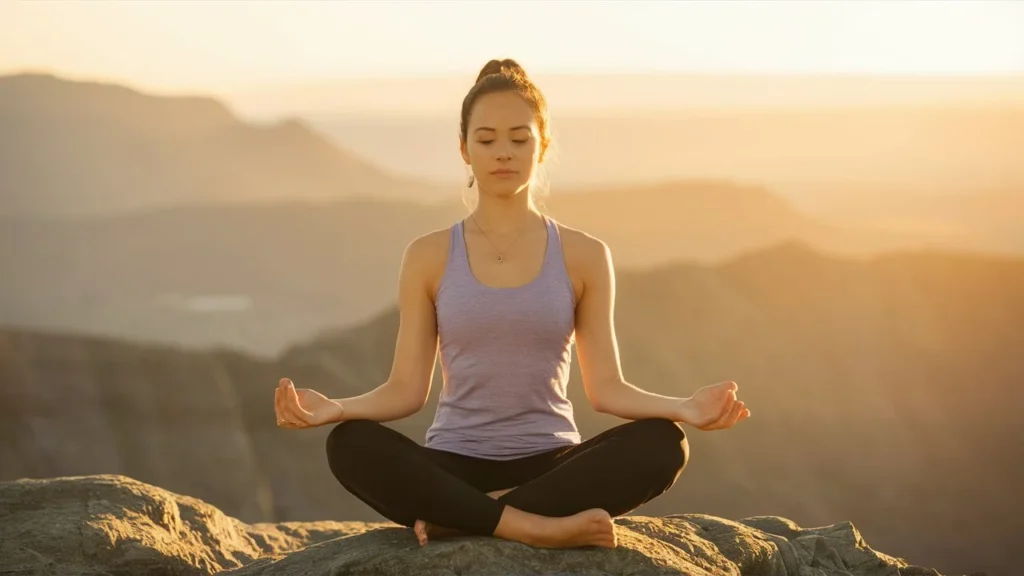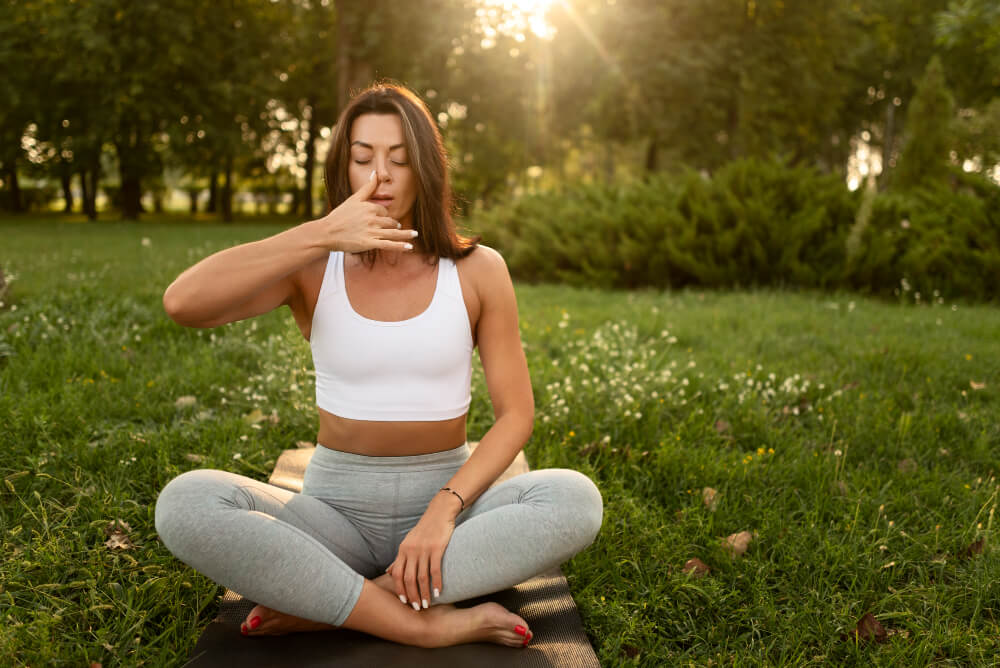
In a world where stress, anxiety, and fast-paced living reign supreme, Pranayama yoga provides a strikingly simple yet effective way to reconnect with your mind and body. Pranayama yogic breathing techniques not only control the breath but also optimize one’s physical and mental health while bringing balance and clarity to one’s life.
Combined with yoga or practiced individually, the term “Pranayama” is derived from two Sanskrit words: “Prana” which means “life force” or “breath,” and “Yama” meaning control or discipline. Its euphonious syllables resonate with the conscious regulation of breath (as it raises one’s awareness to listening to themselves), which is known to influence the flow of ‘Prana’ or Life Energy within the body. Increments in cognitive functioning have shown that regular practice of Pranayama leads to greater clarity, health and emotional stability.
In this blog, we will cover the fundamentals of Pranayama yoga, including its origins, benefits, techniques, and give you actionable advice so that you could easily incorporate it into your daily life. Regardless of whether you are a seasoned practitioner or a complete novice, the remarkable benefits of Pranayama will improve your life significantly.
What is the Meaning of Pranayama ?
Pranayama is an integral part of yoga. Controlled breathing enables both to perform yoga and to calm the mind for meditation. Pranayama is an awareness of the breath. Pranayama is the link that connects your physical yoga practices (asanas) with your mental yoga practices (dhyana).
This is a set of steps to guide your active mind through it to make you feel inner peace. Pranayama is a Sanskrit word which is made up of two words in which the first word is “Prana” meaning “breath” (life force) and the second word “Ayam” which means “control” (extension). If you do Pranayama regularly then it heals our body internally.
Origins and History of Pranayama Yoga
The practice of Pranayama dates back thousands of years to the ancient yogic texts known as the Vedas. The concept of controlling the breath was introduced in the Upanishads and the Yoga Sutras of Patanjali, which are the cornerstone texts of classical yoga philosophy. Patanjali, in his Yoga Sutras, outlines the importance of Pranayama as a means of controlling the fluctuations of the mind and achieving higher states of consciousness.
Over time, Pranayama yoga evolved with different schools of thought and techniques. Today, Pranayama is practiced by millions worldwide for its vast health benefits.
Benefits of Pranayama Yoga
- Improved Mental Health: Pranayama helps calm the nervous system, reduce stress, and alleviate anxiety. By focusing on the breath, individuals can enter a meditative state, which allows them to quiet the mind and release negative thought patterns.
- Enhanced Focus and Clarity: Regular practice of Pranayama improves concentration, mental clarity, and cognitive function. The breath-regulation techniques enable you to stay present in the moment, improving your overall productivity and performance.
- Physical Health Benefits: Pranayama can improve lung capacity, oxygenate the body, and enhance cardiovascular health. It has been shown to reduce blood pressure, strengthen the immune system, and aid in the management of chronic conditions such as asthma and respiratory illnesses.
- Increased Energy and Vitality: Pranayama helps to activate and balance the flow of prana (life energy) within the body. This increased flow of energy can lead to enhanced vitality, increased stamina, and a sense of overall well-being.
- Emotional Healing: Regular practice of Pranayama can help release emotional blockages and foster emotional resilience. By cultivating mindfulness and awareness, individuals can better manage their emotions and develop a deeper connection to their inner selves.
Types of Pranayama Techniques
- Pranava Pranayama
- Sheetali Pranayama (Cooling Breath)
- Ujjayi Pranayama
- Kapalbhati Pranayama
- Dirga pranayama
- Bhastrika Pranayama
- Bahya Pranayam
- Bhramari Pranayama
- Udgeeth Pranayama
- Anulom-Vilom Pranayam
- Agnisar kriya pranayama
1.Pranava Pranayama
How to Practice: Sit in a comfortable position (Sukhasana, Padmasana, or Siddhasana). Close your eyes, focus on your breath, and chant “Om” as you inhale and exhale.
Benefits: Calms the mind, boosts positive energy, and promotes inner peace.
2.Sheetali Pranayama
- How to Practice: Sit in a comfortable position. Inhale deeply through your mouth, rolling the tongue into a tube shape. Exhale through the nose.
- Benefits: Cools the body and mind, helps reduce stress, and improves digestion.
3.Ujjayi Pranayama
- How to Practice: Sit in a comfortable position. Inhale deeply through the nose, creating a soft sound in the throat, similar to the ocean waves. Exhale with the same sound.
- Benefits: Enhances concentration, calms the mind, and creates a sense of relaxation.
Also, Read ⬇️ ⬇️
Ujjayi Pranayama Benefits and Steps
4.Kapalbhati Pranayama
- How to Practice: Sit upright and exhale forcefully through your nose while pulling your abdomen inward. The inhale happens passively.
- Benefits: Improves lung capacity, energizes the body, and clears the mind.
Also, Read ⬇️ ⬇️
Benefits of Kapalbhati Pranayama and the way to Do It
5.Dirgha pranayama
- How to Practice: Inhale deeply in three parts: first into the lower abdomen, then the chest, and finally the upper chest. Exhale in reverse order.
- Benefits: Increases oxygen intake, calms the mind, and promotes deep relaxation.
Also, Read ⬇️ ⬇️
Dirgha Pranayama (Three-Part Breathing): Steps & Benefits
6.Bhastrika Pranayama (Bellows Breath)
- How to Practice: Sit comfortably and take quick, forceful inhalations and exhalations through the nose, creating a pumping motion in the abdomen.
- Benefits: Stimulates the respiratory system, increases energy levels, and clears the mind.
Also, Read ⬇️ ⬇️
Bhastrika Pranayama Benefits, Steps, and Precautions
7.Bahya Pranayama (External Breath)
- How to Practice: After exhaling completely, hold the breath out and perform specific bandhas (body locks), such as Jalandhar Bandha, Udyana Bandha, and Mula Bandha.
- Benefits: Stimulates internal organs, improves lung capacity, and enhances energy flow.
8.Bhramari Pranayama (Bee Breath)
- How to Practice: Close the ears with your thumbs, place the fingers over your eyes, and hum like a bee while exhaling.
- Benefits: Reduces stress, alleviates headaches, and calms the mind.
Also Read ⬇️ ⬇️
Bhramari Pranayama Time Duration
10.Anulom-Vilom Pranayama (Nadi Shodhana or Alternate Nostril Breathing)
- Benefits: Balances the nervous system, enhances mental clarity, and promotes emotional stability.
- How to Practice: Close one nostril and inhale through the other, then switch nostrils and exhale. Repeat this process.
Also, Read ⬇️ ⬇️
Anulom Vilom Pranayama Benefits
11.Agnisar Kriya Pranayama (Fire Cleansing Breath)
- Benefits: Improves digestion, strengthens abdominal muscles, and detoxifies the body.
- How to Practice: After exhaling completely, hold the breath out and pump the belly in and out.
How to Practice Pranayama Yoga
- Choose a Quiet Space: Find a calm and peaceful environment where you can practice without distractions. It is important to be in a space where you feel comfortable and relaxed.
- Start with Simple Techniques: If you’re new to Pranayama, begin with simple techniques such as Nadi Shodhana or Ujjayi breath. As you become more comfortable with these practices, you can explore other techniques.
- Focus on Your Breath: The key to Pranayama is mindfulness. As you practice, direct your attention to your breath, noticing the sensation of the air entering and leaving your nostrils. Breathe slowly, deeply, and consciously.
- Gradually Increase Duration: Start with a few minutes of Pranayama practice and gradually increase the duration as you build your stamina. You can begin with 5-10 minutes a day and eventually work up to longer sessions.
- Incorporate Pranayama into Your Yoga Practice: Pranayama is often used in conjunction with asanas (yoga poses) to deepen the practice and increase its benefits. It helps prepare the body for meditation and promotes relaxation.
Also, Read ⬇️ ⬇️
Which people should do Pranayama Yoga Regularly?
Pranayama plays a very important role in our life. Every human should do Pranayama regularly. For those people who have complaints related to breathing, Pranayama is a panacea for those people. By doing this pranayama, he can control his breath, and can also hold his breath for a long time. Pranayama is very easy for people who are suffering from depression.
There are many people in the world who are complaining about their backbone, Pranayama is a panacea treatment for such persons so that they can overcome all the problems related to their bones. If we are suffering from depression, then pranayama is also the basic treatment for it(1). Therefore, pranayama should be done by people of all ages.
What Precautions Should be Taken in Doing Pranayama Yoga
To practice Pranayama safely and effectively, consider the following precautions:
- Empty Stomach: Practice on an empty stomach, preferably in the morning or several hours after meals.
- Gradual Progression: Start with simple techniques and gradually progress to more advanced practices under the guidance of a qualified instructor.
- Individual Considerations: Adjust the practice according to your health condition, avoiding techniques that may strain or cause discomfort.
- Consistency: Maintain a regular practice schedule to experience sustained benefits over time.
- Expert Guidance: Seek guidance from a certified yoga instructor or healthcare professional, especially if you have pre-existing health concerns or conditions.
Incorporating Pranayama into your daily routine can significantly enhance your physical and mental well-being. Whether you’re new to yoga or an experienced practitioner, exploring different Pranayama techniques can deepen your practice and enrich your life.
Conclusion
In conclusion, Pranayama Yoga is a profound practice that offers numerous benefits for both body and mind. By understanding and practicing different Pranayama techniques, individuals can improve respiratory health, mental clarity, emotional resilience, and overall well-being. With consistent practice and mindfulness, Pranayama can help you unlock your full potential and achieve greater harmony in your life.
Embrace Pranayama Yoga today, and experience the transformative power of your breath.
Frequently Asked Questions (FAQs)
Q1. What is the best time to practice Pranayama?
Ans: Pranayama is best practiced early in the morning, on an empty stomach. This is when your mind is calm, and the air is fresh. However, if mornings are not convenient, you can practice it any time during the day, as long as you haven’t recently eaten.
Q2. How long should I practice Pranayama each day?
Ans: If you’re a beginner, start with 5-10 minutes of Pranayama practice per day. As you become more comfortable, you can gradually increase the duration to 15-30 minutes. Consistency is key to experiencing the benefits, so try to practice regularly.
Q3. Can Pranayama be practiced by beginners?
Ans: Yes! Pranayama is accessible to all levels, including beginners. Start with simple techniques such as Nadi Shodhana (Alternate Nostril Breathing) or Ujjayi Pranayama. As you become more familiar with the practice, you can explore more advanced techniques.
Q4. What if I feel dizzy or uncomfortable while practicing Pranayama?
Ans: It’s normal to feel lightheaded when you’re new to Pranayama, especially during deep breathing exercises. However, if dizziness persists or if you feel uncomfortable, stop and return to a natural breathing rhythm. Always listen to your body. If you’re new to Pranayama, practice under the guidance of a trained instructor to ensure you’re doing the techniques correctly.
Q5. Can Pranayama help with anxiety and stress?
Ans: Yes! Pranayama is highly effective in reducing anxiety and stress. By focusing on controlled breathing, the nervous system is soothed, and the body enters a relaxed state. Techniques like Anulom-Vilom (Alternate Nostril Breathing) and Bhramari (Bee Breath) are particularly helpful in calming the mind and reducing anxiety.
Q6. Can Pranayama improve sleep quality?
Ans: Yes, practicing Pranayama before bedtime can significantly improve sleep quality. Techniques like Nadi Shodhana (Alternate Nostril Breathing) calm the nervous system and prepare the body for restful sleep. By incorporating Pranayama into your evening routine, you can experience deeper, more restorative sleep.


